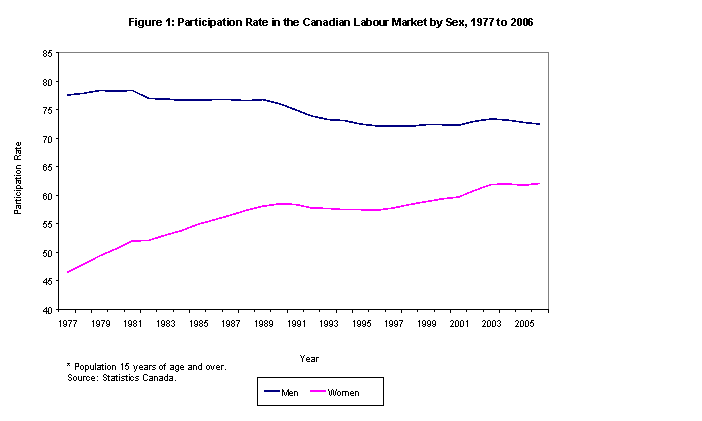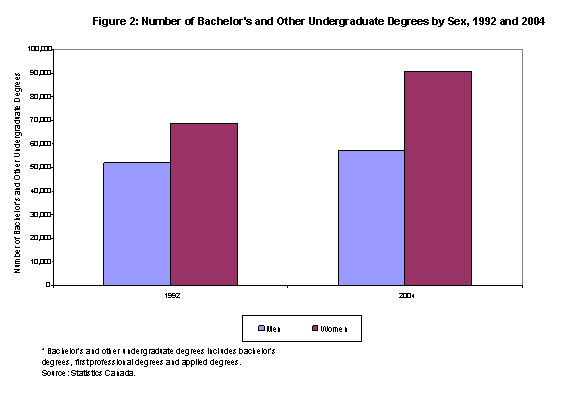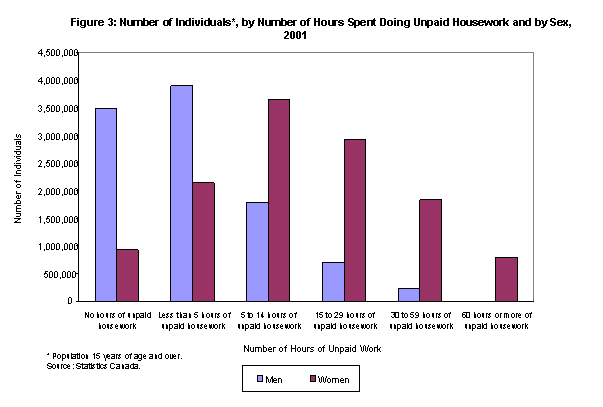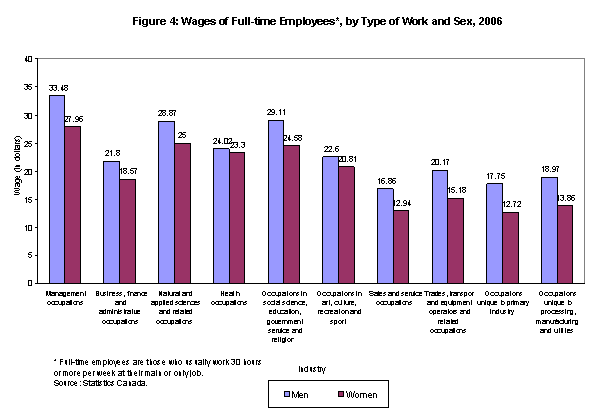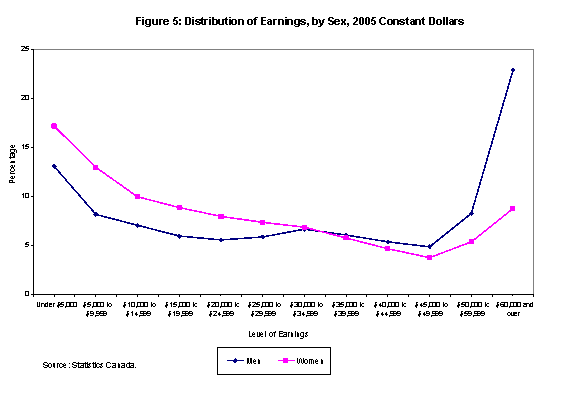FEWO Committee Report
If you have any questions or comments regarding the accessibility of this publication, please contact us at accessible@parl.gc.ca.
|
CHAPTER II. THE CONTEXT FOR GENDER RESPONSIVE BUDGETING Women are half of the nation’s electorate and we make up almost half of the nation’s taxpayers, up from just 30% a generation ago. At last count, we paid $42 billion in personal income taxes alone, and that amount keeps rising. We are a big constituency and we deserve a respected and equal place in every budget that every government in this nation prepares.[4] This chapter provides background information to help situate gender responsive budgeting within Canada’s international and national commitments to gender equality. It begins with an overview of statistical data that the Committee heard on the status of women in Canada today. The chapter then explains how gender-based analysis and gender responsive budgets contribute to attaining the goal of gender equality. The Committee recognizes that Canada’s international obligations must be considered in any discussion relating to the implementation of gender responsive budgets. A. The Status of Women in Canada: A Brief Overview Although the status of women has greatly improved in Canada in the last fifty years, witnesses informed the Committee that they are concerned with the deterioration of Canada’s international gender gap rankings. Since the late 1990s, Canada has lost its renowned spot as number one in both the human development index and the gender development index in the UN human development reports. It has been falling every year since then in its ratings, particularly in relation to women. It has most recently fallen down to number seven in the world from number one in just a few short years. A new set of indicators that puts more emphasis on the economic functioning of the different indicators ranked Canada, in terms of the gender gap between women and men in 2006, at number 14, and in 2007, at number 18. So things are moving backwards for women in Canada in hard dollars and cents.[5] The Committee recognizes that women have improved their labour market participation as well as their level of educational attainment. For example, the participation rate[6] of the Canadian population to the labour market has significantly evolved with respect to gender over the last three decades. Figure 1 provides a graphical representation of such evolution. From a low of 46.5% in 1977, women’s participation rate to the Canadian labour market increased to 62.1% in 2006. Men’s participation rate, however, decreased slightly from 77.6% to 72.5% between 1977 and 2006.
Furthermore, the educational attainment of women relative to men has significantly improved over the last few decades. Figure 2 provides a graphical comparison of the number of bachelor’s and undergraduate degrees obtained by men and women in 2004 relative to 1992.
Nonetheless, the Committee is concerned with the gender inequalities that persist in Canadian society. Witnesses provided the Committee with national statistics and indicators that demonstrate Canada’s gender inequalities. For example, Professor Kathleen Lahey from Queen’s University indicated that the data demonstrate that women continue to do most of the unpaid work: Women do more work than men do in this economy, but men have the lion's share of the paid work, and women have the lion's share of the unpaid work. One of the goals of gender equality is to bring those into line. It's not just to give women as much income as men. It's to also make sure that women do a better mix of paid and unpaid work and that men do a better mix of paid and unpaid work, so that the population as a whole becomes healthier and more productive.[7] As can be seen from Figure 3, the number of women performing five hours of unpaid housework and more during the week is considerably higher compared to men.
The Committee also heard that the income wage gap between women and men continues to exist in Canada at about 30%: In terms of the income wage gap, it hasn't really changed over the last seven, eight, nine years. It's remained at about 30%, and doesn't seem to be changing.[8] Statistics Canada officials informed the Committee that the income wage gap even exists for young women: Recent analysis, looking at the wage gap for young women—thinking that maybe the baby boomers still going through are having a negative impact—finds that even amongst young women who are highly educated, there's still a 20% gap. It's probably related to occupational segregation: women are in jobs where the real wage isn't improving, where the men are in jobs where it is.[9] As Figure 4 demonstrates, the wage gap between men and women in full-time employment is significant, although the magnitude of such difference varies considerably by type of work performed. It presents wages of full-time employees by type of work performed for 2006.
A distribution of earnings[10] by sex is a graphical representation of the percentage of men and women at each level of earnings. As can be seen from Figure 5, the percentage of women is higher than the percentage of men for all earnings below the $30,000 to $34,999 earnings level, at which point both distributions intersect. For all level of earnings above the intersection point, the percentage of men becomes higher than that of women.
The Committee heard repeatedly that women’s incomes fall into the bottom tax income brackets. As Table 1 demonstrates, 68% of women, as compared to 49% of men, have taxable income of less than $40,000. Table 1: Taxable Incomes of Men and Women, 2005[11]
Finally, the Committee notes that women continue to be heavily under-represented in positions of power within federal, provincial and territorial governments. The following table demonstrates the representation of female parliamentarians in the House of Commons and the Senate as of May 1, 2008. Table 2: Representation of Female Parliamentarians in Canada, May 2008
At the time this report was being prepared, there were seven female ministers in the federal Cabinet, representing approximately 22% of the total number of Cabinet ministers. B. Canada’s International Obligations The Committee heard from several witnesses that Canada’s approach to achieving gender equality and to developing gender responsive budgets must be addressed in the context of whether it is meeting its international obligations under the United Nations (UN) Convention on the Elimination of All Forms of Discrimination Against Women (CEDAW) and under the Beijing Declaration and Platform for Action. CEDAW was adopted by the UN General Assembly in 1979, and is often described as an international bill of rights for women. When Canada ratified the Convention in 1981, it committed itself to setting up an agenda for national action to end discrimination against women. The UN Expert Committee on the Elimination of All Forms of Discrimination Against Women, which was established in 1982, has reported on Canada’s compliance with CEDAW and made several recommendations. Nancy Peckford, Program Director with the Canadian Feminist Alliance for International Action (FAFIA), encouraged the Committee to consider these recommendations as part of the implementation of a gender responsive budget initiative: [O]ne of the other purposes of doing gender budgeting is to help countries reconcile international commitments with domestic realities. One of the best ways Canada could do this is to look at the recommendations that came from the UN Committee on the Elimination of Discrimination Against Women back in 2003. There is a set of recommendations on the table that deal with a range of women's realities, whether it be affordable housing, poverty, employment, child care, discrimination against aboriginal women, or other matters.[12] Canada’s international obligations also flow from its adoption of the Beijing Declaration and Platform for Action. In 1995, the Fourth UN World Conference on Women was held in Beijing, China, where UN Member States, including Canada, adopted the Beijing Declaration and Platform for Action. Since its adoption, member states have participated in five year reviews and appraisal of commitments made to gender equality. Canada took part in the Beijing +5 and +10 in 2000 and 2005 respectively.[13] The Beijing Declaration and Platform for Action identified strategic objectives and actions in 12 critical areas of concern including poverty, education and training, health, violence against women, armed conflict, economy, power and decision-making, institutional mechanisms for the advancement of women, human rights of women, media, environment and the girl-child.[14] In adopting the Beijing Declaration and Platform for Action, governments throughout the world committed themselves to effective integration of a gender perspective throughout their operations, policies, planning and decision making. Governments also adopted the obligation to carry out gender impact assessments of the effects of government bills or political initiatives on women and men before final decisions could be taken. In Canada, the federal government has put in place two five-year plans on gender equality, the Federal Plan for Gender Equality (1995-2000) and the Agenda for Gender Equality (2000-2005). Gender-based analysis has been a key component of both these action plans. In Canada’s 1995 action plan for implementing the Beijing Declaration and Platform for Action, Setting the Stage for the Next Century: Federal Plan for Gender Equality[15], the Canadian government adopted a policy requiring federal departments and agencies to conduct gender-based analysis of policies and legislation. While each department is responsible for conducting gender-based analysis, Status of Women Canada provides training and support for GBA activities in its role as the agency responsible for gender equality.[16] More recently, the 2008 Federal Budget announced that the federal government will be developing an “Action Plan that will advance the equality of women across Canada.”[17] The Committee heard from several witnesses that gender responsive budgets and gender-based analysis serve as tools for achieving gender equality and for improving the public policy process. As Professor Ellen Russell from the School of Public Policy and Administration at Carleton University, explained: You stand to design policies that are much better designed to meet their desired objectives because you've taken into account the gender landscape in which these policies have to exist. It's like this: you could hire an architect to design a house, and that architect might do a quite capable technical job, but unless they go there and see things--was there a hill, was there a drainage problem, was there erosion--they don't make the plans in full awareness of the actual obstacles on the ground.[18] Witnesses presented to the Committee their definitions of these tools and what they signified for them. Several witnesses emphasized that these tools cannot accomplish much if they are not incorporated within a global vision and a broader set of objectives. One of the witnesses noted that a gender budget is useless as a tool unless it is part of an action plan.[19] Georgina Steinsky-Shwartz, Former Chair of the Expert Panel on Accountability Mechanisms for Gender Equality, pointed out that both gender responsive budgets and gender-based analysis are tools but “not the final outcome.” [20] 1. What Is Gender-Based Analysis? Gender-based analysis is a tool for analyzing the differential impacts policies have on women and men. A good GBA requires a certain level of technical competence. As one of the witnesses commented: [G]ender-based analysis, is not something that comes from the moon. It's not rocket science, but it does need to be grounded in some technical competence.[21] The Committee heard two definitions of GBA. First, Status of Women Canada provided the Committee with the federal government’s definition: GBA is an analytical tool, an important part of a comprehensive social/economic analysis of public policy. GBA takes into account social and economic differences between the sexes at every stage of policy development to ensure that potential differential impacts are identified, and that existing and proposed policies have intended and equitable results for both sexes. GBA uses gender relations as its analytical focus rather than viewing women in isolation from men and vice versa. GBA means working towards woman-specific initiatives and mainstreamed policies and programs targeting gender equality as an outcome. This is the ideal situation. GBA is a sequential process. There are certain steps that can be undertaken in the immediate term, while others require more time to refine or accomplish.[22] Then, Ms. Peckford provided the Committee with a broader definition as stated in the 1995 Federal Plan for Gender Equality: Gender-based analysis begins with the assumption that social, economic, cultural and political arrangements are entwined with all public policy. Such a complex reality requires a complex set of policy responses. Central to this assumption is the need to assess the different impacts that policies may have on women and men. A gender-based approach ensures that the development, analysis and implementation of legislation and policies are undertaken with an appreciation of gender differences. This includes an understanding of the nature of relationships between men and women, and the different social realities, life expectations and economic circumstances facing women and men.[23] The Committee also heard testimony on the culturally balanced gender-based analysis framework developed by the Assembly of First Nations. As Kathleen McHugh, Interim Council Chair, Assembly of First Nations Women’s Council explained: We firmly believe our GBA will get better results for First Nations women than other approaches, because it overlays gender analysis with a historical understanding of our culture. It asks policy-makers to look at the central role women played in pre-contact cultures, and how and why change occurred after contact. It asks them to offer options based on this context. In plain language, it explains how First Nations women see themselves and where they want to go from here.[24] 2. What Is a Gender Responsive Budget? Professor John Bartle, Director of the School of Public Administration at the University of Nebraska, explained to the Committee that a gender responsive budget is “a government budget that explicitly integrates gender into any or all of the parts of the decision-making process regarding [resource] allocation and revenue generation.”[25] In its submission to this Committee, the International Development Research Centre stated that gender responsive budgeting “requires government officials to think about finances in a new way”, to look “beyond the household to examine how budgets address the needs of male and female members.”[26] Professor Russell indicated that a gender responsive budget is “a powerful tool to make sure all policies are well designed, cost-effective, and accountable.”[27] Armine Yalnizyan, Senior Economist with the Canadian Centre for Policy Alternatives, described gender responsive budgets as “lift[ing] the veil on what governments are doing and for whom.” Gender budgeting is not just about the number of times women are mentioned or focusing on measures that just affect women. Gender analysis of a budget lifts the veil on what governments are doing and for whom. It reveals the high cost of a political agenda that has focused for over a decade now on tax cuts.[28] In her testimony, Professor Lahey stated that, given Canada’s international human rights commitments and its commitment to gender equality under its 1995 Federal Plan for Gender Equality, a gender budget can be viewed as another mechanism for integrating gender-based analysis into the functioning of government.[29] She described these tools as inter-linked since a gender-based analysis cannot be completed without also devising a gender responsive budget: So I would say that gender-based analysis cannot be completed until a gender budget is also devised and gender-based analysis is used in relation to every single spending and tax item, to identify both its physical and its behavioural impacts on women as compared to men. But until a gender budget is put on the table right along with the rest of the budget documents, the process is not complete.[30] Professor David Good from the School of Public Administration at the University of Victoria found the term gender budgets to be a “misnomer.” He informed the Committee that gender is one factor that needs to be considered among several other factors in the budget process. To say that a budget is gender based is a factor and it’s one of the inputs into the budget, but I think it’s a far cry to say that all budgets ought to be necessarily gender based. There are many other factors that will enter into the budget.[31] He pointed out that his preference is for a “gender-informed budget, a budget that is informed by analysis, informed by priorities, informed by dialogue, informed by thought, and informed by debate, so that the gender implications of what is being done are looked at, analyzed, thought about, and brought to bear in the budget.”[32] The Committee heard from Ms. Budlender, an expert in the area of gender budgeting, that her preferred term is “gender responsive budgeting.”[33] The term gender responsive budgeting reflects the Committee’s approach to integrating gender into the budgetary process and into the federal government’s spending and taxation policies. D. Why Should We Do Gender Responsive Budgets? According to the World Economic Forum[34], gender inequality is inefficient and costly to women, men, girls and boys. These costs are manifested by lower levels of productivity, competitiveness and reduced levels of well-being.[35] Diane Elson, Professor at Exeter University and an expert in the area of gender responsive budgeting, argues that “if women themselves have more control over resources there will be gains for society as whole; but if gender inequality persists, there will be continuing losses for society as a whole.”[36] A national budget that is gender responsive recognizes the underlying inequalities between women and men and redresses them through the allocation of public resources.[37] It also views women not as “a vulnerable group who are the beneficiaries of government assistance but rather as rights holders, whose governments are under obligation to empower and protect.”[38] Clare Beckton, Coordinator for Status of Women Canada, informed the Committee that gender responsive budgeting “reduces the socio-economic disparity between the sexes” and “may also improve effectiveness, efficiency, accountability and transparency of government budgets.”[39] Ms. Peckford indicated to the Committee that gender responsive budget initiatives have become a global phenomenon both among developing and developed countries. Gender responsive budgets are a tool for correcting gender inequalities: What is helpful to us, in thinking about this, is that this is not simply a phenomenon of countries in the global south; it is actually a phenomenon of countries the world over. It's not simply for the purposes of better or more effective development aid that you engage in gender budgeting; it's something you do if you are committed to accountability, transparency, responsive government, and really good governance.[40] Ms. Peckford also underlined the need for “up-fronting women’s equality” in a gender-based analysis of the budget: I am very concerned that gender-based analyses that may be occurring are not necessarily up-fronting women's equality considerations. The only reason we would do gender-based analysis of a federal budget is that we are concerned that women are differently located in the economy, in society, and in their families, and that as a consequence, budgetary measures—on the revenue or the expenditure side—will affect them differently. This is really important to keep in mind when we're thinking about a gender-based analysis. [41] E. Assessing the Quality of the Gender-Based Analysis of a Budget In her submission to the Committee, Professor Lahey outlined a framework for evaluating the quality of a gender-based analysis of the budget. The following table delineates the basic types of gender analyses relevant to this assessment. Table 3: Basic Types of Gender Analysis[42]
The budget has become central to governing and has grown to reflect government priorities. Professor Good reminded the Committee that “the budget is fundamentally an analytical process as well as very much a political process.”[43] According to him, the budget can be viewed as consisting of five distinct components:
Robert Wright, Deputy Minister of Finance Canada, indicated to the Committee that the “budget is a process—it’s a machine between September and late February to get things done.”[45] As the report will discuss in later chapters, central agencies are important contributors to the budgetary process. The Committee also heard about the role the Minister of Finance plays in the budgetary process: The minister, for example, meets with all of his colleagues in cabinet on budget process; he meets with his caucus colleagues; he meets with the opposition leaders; he listens to committees like this one and like the overall finance committee, which has broad-based consultations; and he meets with a lot of Canadians.[46] The Deputy Minister of Finance explained to the Committee that Finance Canada’s role is to ensure that both the Minister of Finance and the government make informed decisions.[47] Finance Canada began to implement a gender-based analysis of tax policies changes in 2006. The Committee has received Finance Canada’s GBA reports for 2006, 2007 and 2008, and has heard testimony analyzing the Department’s approach. Chapters V and VI address in greater detail the Committee’s concerns with Finance Canada’s approach to GBA. In addition, witnesses explained to the Committee that when examining budgets, one has to look at both the expenditure side and the tax side. As Professor Good noted: Both of those sides do have major implications and ramifications with respect to gender. They have differential impacts, depending upon what those measures might be, on the expenditure side and on the tax side—differential impacts in terms of impacts on men and women in various policies.[48] Government spending can take the form of either direct spending or tax expenditures such as reductions in income tax rates, deductions, benefits, supplements and credits. A gender responsive budget takes into account the effects of these forms of spending on women and men and on groups of women and men. As Dr. Bartle and Dr. Rubin explained in their publication on gender responsive budgets: Government budgets are generally presented in financial aggregates, with no specific references to men or women. As such, the budget appears to be gender neutral. But if revenue and expenditure decisions have differential impacts on men and women, the budget is not gender neutral; to ignore the differences constitutes what has been termed “gender blindness.”[49] [4] Armine Yalnizyan, Senior Economist, Canadian Centre for Policy Alternatives, FEWO Evidence, 13 March 2008 (0915). [5] Kathleen Lahey, Professor, Institute of Women's Studies, Queen’s University, FEWO Evidence, 28 November 2007 (1540). [6] The participation rate for a particular group (age, sex, marital status, geographic area, etc.) is the total labour force in that group, expressed as a percentage of the population 15 years of age and over, in that group. [7] Kathleen Lahey, Professor, Institute of Women’s Studies, Queens University, FEWO Evidence, 1 April 2008 (1020). [8] Heather Dryburgh, Chief of the General Social Survey, Social and Aboriginal Statistics Division, Statistics Canada, FEWO Evidence, 17 April 2008 (1020). [9] Ibid. [10] This includes earnings from both paid employment (wages and salaries) and self-employment. [11] Armine Yalnizyan, Budget 2008: What’s In It for Women?, Canadian Centre for Policy Alternatives, March 2008, p. 14. [12] Nancy Peckford, Program Director, Canadian Feminist Alliance for International Action, FEWO Evidence, 13 March 2008 (0945). [13] Status of Women Canada, « Beijing +10: Fact Sheets », available at: http://www.swc-cfc.gc.ca/pubs/b10_factsheets/factsheet_3_e.html. [14] United Nations, The Beijing Declaration and the Platform for Action, Fourth World Conference on Women, Beijing, China, September 1995. [15] Status of Women Canada, Setting the Stage for the Next Century: The Federal Plan for Gender Equality, August 1995, available at: http://www.swc-cfc.gc.ca/pubs/066261951X/index_e.html. [16] Standing Committee on the Status of Women, Gender-Based Analysis: Building Blocks for Success, April 2005, p. 2. [17] Government of Canada, The Budget Plan 2008. Responsible Leadership. February 2008, p. 118. [18] Ellen Russell, Professor, School of Public Policy and Administration, Carleton University, FEWO Evidence, 3 December 2007 (1715). [19] Armine Yalnizyan, Director of Research, Community Social Planning Council of Toronto, FEWO Evidence, 5 December 2007 (1540). [20] Georgina Steinsky-Shwartz, President and CEO Imagine Canada, Former Chair of Expert Panel on Accountability Mechanisms for Gender Equality, FEWO Evidence, 8 April 2008 (0900). [21] Dorienne Rowan-Campbell, Development and Gender Consultant, Former Member Expert Panel on Accountability Mechanisms for Gender Equality, FEWO Evidence, 8 April 2008 (0905). [22] Status of Women Canada, Definition of Gender-Based Analysis (GBA). [23] Nancy
Peckford, Program Director, Canadian Feminist Alliance for International
Action, FEWO Evidence, [24] Kathleen McHugh, Interim Council Chair, Assembly of First Nations Women’s Council, FEWO Evidence, 10 April 2008 (1005). [25] John R. Bartle, Director and Professor, School of Public Administration, University of Nebraska at Omaha, FEWO Evidence, 3 December 2007 (1535). [26] International Development Research Centre, “Budgeting for Greater Equality”, Submission to the House of Commons Standing Committee on the Status of Women, April 25, 2008. [27] Ellen Russell, Professor, School of Public Policy and Administration, Carleton University, FEWO Evidence, 3 December 2007 (1545). [28] Armine Yalnizyan, Senior Economist, Canadian Centre for Policy Alternatives, FEWO Evidences, 13 March 2008 (0915). [29] Kathleen Lahey, “The Gender Budget: Gender-based Analysis of Revenues and Expenditures”, Submission to the House of Commons Standing Committee on the Status of Women, 28 November 2007, p. 4. [30] Kathleen Lahey, Professor, Institute of Women's Studies, Queen’s University, FEWO Evidence, 28 November (1610). [31] David Good, Professor, School of Public Administration, University of Victoria, FEWO Evidence, 28 February 2008 (0915). [32] Ibid. (0915). [33] Debbie Budlender, Specialist Researcher, Community Agency for Social Enquiry, South Africa, FEWO Evidence, 10 December 2007 (1645). [34] The World Economic Forum is a non-partisan independent international organization engaging leaders in partnerships to shape global, regional and industry agendas. For more information, see: http://www.weforum.org/en/index.htm [35] The World Economic Forum incorporated gender equality as a measure of economic competitiveness and has developed a Gender Gap Index. [36] Diane Elson, “Integrating Gender into Government Budgets within a Context of Economic Reform,” in Debbie Budlender, et al., Gender Budgets Make Cents, Commonwealth Secretariat, London, 2002, p. 25. [37] Helena Hofbauer Balmori, Gender and Budgets, BRIDGE, University of Sussex, February 2003, p. 5. [38] Noleen Heyzer, “Preface”, in Diane Elson, Budgeting for Women's Rights: Monitoring Government Budgets for Compliance With CEDAW, UNIFEM 2006, p. 1. [39] Clare Beckton, Coordinator, SWC, FEWO Evidence, 10 December 2007 (1545). [40] Nancy Peckford, Program Director, Canadian Feminist Alliance for International Action, FEWO Evidence, 13 March 2008 (0940). [41] Ibid. (0945). [42] Kathleen Lahey, “Critique of the Department of Finance Gender Analysis of Tax Measures in Budgets 2006 and 2007”, Submission to the Standing Committee on the Status of Women, April 1, 2008. [43] David Good, Professor, School of Public Administration, University of Victoria, FEWO Evidence, 28 February 2008 (0905). [44] David Good, The Politics of Public Money, University of Toronto Press, Toronto, 2008, p. 46. [45] Robert Wright, Deputy Minister, Finance, FEWO Evidence, 15 April 2008 (0855). [46] Ibid. (0845). [47] Ibid. [48] David Good, Professor, School of Public Administration, University of Victoria, FEWO Evidence, 28 February 2008 (0905). [49] Marilyn M. Rubin and John R. Bartle, “Integrating Gender into Government Budgets: A New Perspective,” Public Administration Review, Vol. 65, No. 3, 2005, pp. 259-272, p. 260. |
